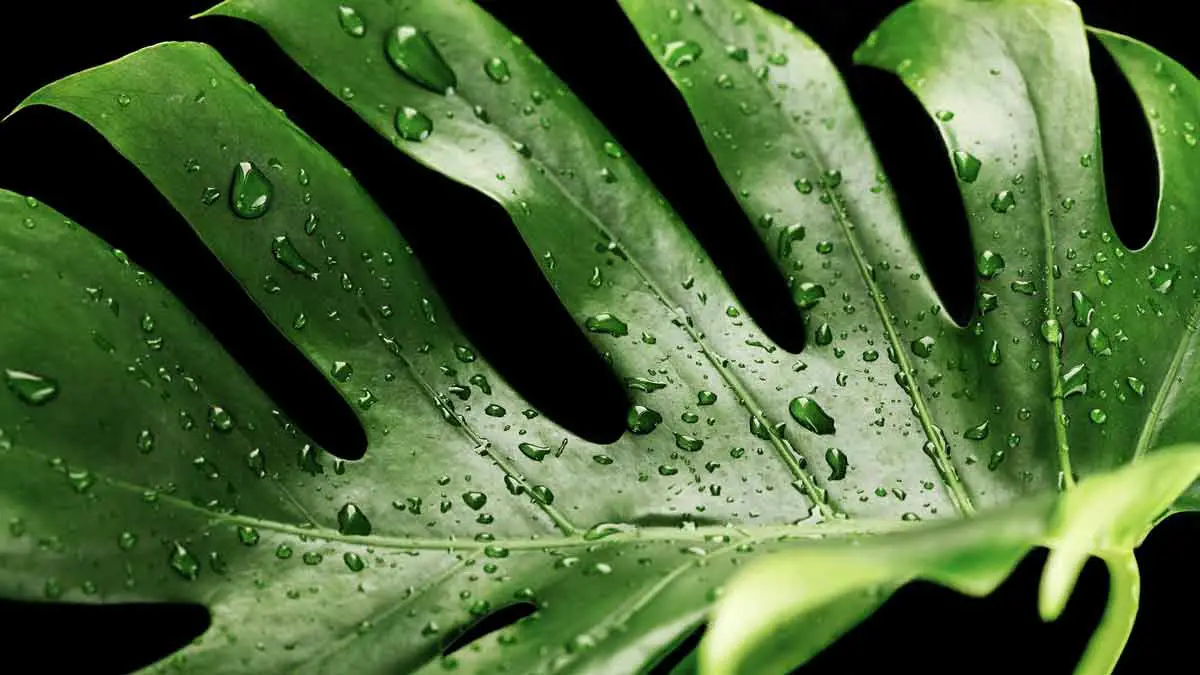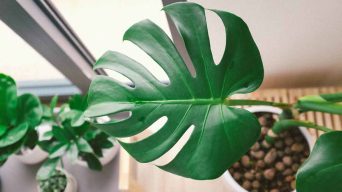Taking care of a Monstera plant, also known as split-leaf philodendron or Swiss cheese plant, requires understanding the right amount of humidity it needs to thrive. With proper care, Monsteras are known for their lush foliage and can help spruce up any room in your home.
But providing them with the right environment is vital!
So, do Monstera plants like to be misted? Only sometimes, since misting raises the humidity levels for short periods and could cause more harm than good.
Misting your Monstera can be beneficial sometimes, but you need to take into account the natural humidity levels of your area, as this could create an environment that’s not suitable for your Monstera.
Should Monstera Plants Be Misted?
The answer to this depends on the environment, as some areas are naturally more humid than others.
If you live in a low humidity area, misting your Monstera once or twice a week can help increase its humidity levels. But misting alone isn’t enough.
You should also consider some of these other tips to maintain the proper humidity levels:
- Place a small humidifier near the pot of your Monstera plant. This will help create an environment with higher humidity levels and is especially important for those who live in areas where the air tends to be dryer.
- Place a tray filled with pebbles near your Monstera and fill it with water. This will create a humid environment, even in the driest of climates.
- Group plants that require similar humidity levels within a single area or room to maximize their potential for growth and health.
- Make sure to check the humidity levels within your home regularly and adjust depending on the needs of your Monstera plant.
On the other hand, if you live in a naturally humid environment, misting isn’t necessary and could do more harm than good.
When you live in an area with naturally high humidity, your Monstera won’t need extra misting. However, it’s essential to consider any shifts in humidity levels due to weather or season changes.
What Are the Ideal Humidity Levels for Monstera?
Monstera plants are native to tropical rainforest environments, so their ideal humidity level should be similar.
Experts recommend keeping a humidity range of 60-80% for Monstera plants.
You can check your home’s moisture levels with a hygrometer or digital thermometer/humidity gauge. This way, you can be sure that your Monstera is getting the ideal environment to thrive in.
You can also know if your Monstera needs more humidity by looking for signs of distress.
There are some symptoms you can watch out for to identify if your Monstera is not getting the proper humidity levels.
What Are the Symptoms of a Monstera That Is Not Getting Enough Humidity?
If your Monstera isn’t getting enough humidity, you may notice some of these symptoms:
- Browning of the edges or tips of the leaves
- Yellowing and wilting of the leaves
- Slow growth rate
- Drooping leaves
- Curling leaves
If you notice any of these signs, then it’s a good idea to increase the humidity levels in your home.
What Are the Symptoms of a Monstera That Is Getting Too Much Humidity?
On the flip side, if your Monstera is getting too much humidity, you may notice some of these symptoms:
- Fungal or bacterial infections
- Discoloration in the form of yellow or brown patches on the foliage
- Mushy or foul-smelling roots
- Mold or mildew on the soil
- Excess growth of aerial roots
If you notice any of these signs, then take steps to decrease the humidity levels in your home.
How Often Should You Mist Your Monstera Plant?
In general, misting should only be done if necessary, and the number of times you need to do it depends on your environment.
In addition to the humidity level, you should also consider your home’s temperature and light levels.
When you live in a hot and dry climate, misting your Monstera every couple of days can help relieve it.
If you live in a more moderate climate, misting once or twice a week should be enough.
However, misting isn’t necessary if you live in a naturally humid environment and could do more harm than good.
It’s important to remember that each situation is different, so it’s best to assess the humidity levels in your home and adjust accordingly.
Here are some tips to help you know when and how to mist your Monstera plant:
Check the Humidity Level of Your Room
The first step is to check the relative humidity in your room with a hygrometer or digital thermometer/humidity gauge.
This will help you determine whether your Monstera needs any extra misting.
If the Humidity Level Is Below 40%, Consider Misting Your Monstera
For Monstera plants to survive, the humidity level must be at least 40%. If the humidity is below this level, it’s a good idea to mist your Monstera.
You should also use a spray bottle filled with filtered or distilled water.
In addition to misting, use other methods to increase humidity, such as a humidifier, pebble tray, or misting fountain.
If the Humidity Level Is Above 60%, Don’t Mist Your Monstera
When the humidity level is above 60%, it is not recommended to mist your monstera plant. Misting will last just a few minutes and will not increase the humidity level any further.
It may also cause damage to your Monstera plant by introducing too much moisture.
Instead, ensure your Monstera gets enough airflow by keeping its leaves away from walls and other obstructions.
Mist Your Plant in the Morning for the Best Results
If you do decide to mist your Monstera plant, make sure to do it in the morning. Misting in the evening can harm your plant because it takes too long for the moisture to evaporate, leading to rot or mold.
Also, avoid misting during mid-day because the sun’s rays can cause the water to evaporate too quickly, leaving your Monstera without the moisture it needs.
Make Sure You Mist the Leaves, Not the Soil
When misting your Monstera, make sure to do it on the leaves and not on the potting soil. Directly spraying the soil can cause waterlogging, leading to rotting roots.
Your Monstera will benefit more from misting if you direct it toward the leaves, which will help keep them hydrated and healthy.
What Are the Benefits of Misting a Monstera Plant?
Misting a Monstera plant has its benefits and risks. It is essential to understand these before deciding how often and how much you should mist your Monstera.
The benefits of misting a Monstera plant include the following:
1. Misting a Monstera Plant Will Help It to Stay Hydrated and Healthy
Misting a Monstera plant will help to increase the humidity levels around the plant, which is beneficial for the plant’s health. It also helps to distribute water droplets quickly and evenly around the plant, which can help provide humidity.
2. Misting Will Also Help to Keep the Plant From Getting Dirty
Misting a Monstera plant will help to keep the leaves from getting dusty or dirty. Like rain, misting will also help to wash away any dirt or debris that may have accumulated on the leaves.
It is best to follow up with a wipe down of the leaves after misting to keep them as dry as possible.
3. Misting Will Help to Keep the Plant From Getting Too Hot
Misting a Monstera plant will also help to cool it down in hot climates. This is because the mist will absorb some of the heat and humidity, keeping it cooler than if the plant were left alone.
This reduces the amount of water loss due to evaporation.
4. Misting Will Help to Keep the Plant From Getting Too Dry
Misting a Monstera plant will also help to keep it from becoming too dry. This is because the mist will help replenish some of the moisture that has been lost through evaporation.
Hot and dry climates can be particularly detrimental to a Monstera plant, so misting will help to keep the leaves and soil hydrated.
5, Misting Will Help to Reduce Pests
Misting a Monstera plant can also help reduce pests like aphids and spider mites.
This is because the mist will wash away some of these pesky critters and any eggs or larvae that may be present on the plant leaves or in the soil.
What Are the Risks of Misting a Monstera Plant?
Although there are many benefits to misting a Monstera plant, it is also crucial to understand the potential risks.
The risks of misting a Monstera plant include the following:
1. Misting Can Lead to Too Much Moisture
If your Monstera is already in an environment with high humidity levels, then misting could lead to too much moisture, and this could cause the leaves to become yellow or brown as a result of overwatering.
Overwatering a Monstera is one of the most common causes of plant death, so it is essential to be mindful of how much misting you are doing and to monitor the soil moisture levels regularly.
2. Misting Can Cause Fungal Diseases and Rot
Misting a Monstera plant can also lead to fungal diseases and root rot if it is not done correctly or if the humidity levels are already high enough.
Fungal diseases can quickly kill a Monstera plant, so it is crucial to take precautions when misting.
Common fungal diseases such as powdery mildew, downy mildew, and black spot can be prevented by reducing the amount of misting you do and also monitoring the humidity levels in your home.
3. Misting Can Not Provide Enough Humidity
Misting a Monstera plant is not always enough to provide the necessary humidity levels for the plant to stay healthy.
In particularly dry environments, misting may not be enough to raise the humidity levels in the air, and you may need to use a humidifier or a pebble tray to keep your Monstera healthy.
4. Misting Can Lead to Leaf Damage
Misting a Monstera plant too often can lead to leaf damage, as the droplets can cause the leaves to become too wet, which can lead to yellowing or brown spots.
It is essential to monitor the humidity levels in your home and mist only when necessary.
5. Misting Can Lead to Mold Growth
Misting a Monstera plant too often can also lead to mold growth. The droplets can accumulate on the leaves, providing an ideal environment for fungi and bacteria to grow.
It is essential to monitor the humidity levels and mist only when necessary to prevent mold from taking hold.
Final Thoughts
Growing Monstera plants is not difficult, but it requires some care and attention.
Proper watering, light, temperature, and humidity levels will help ensure your houseplant thrives.
Misting a Monstera plant can be beneficial in certain situations and environments. Still, it is crucial to understand the potential risks as well.
Monitor the humidity levels in your home and mist only when necessary to keep your Monstera healthy and happy.
If you need more humidity than misting can provide, you can use a room humidifier, a pebble tray, or other methods to add moisture to the air.
With some basic care and attention, you can ensure your indoor plants grow healthy and strong for years!







